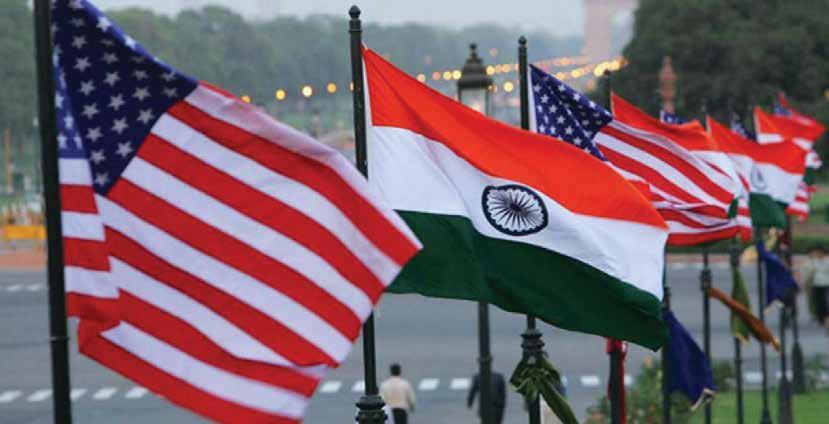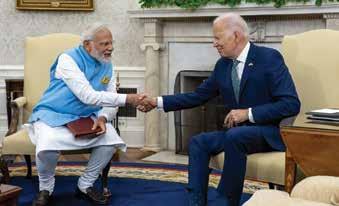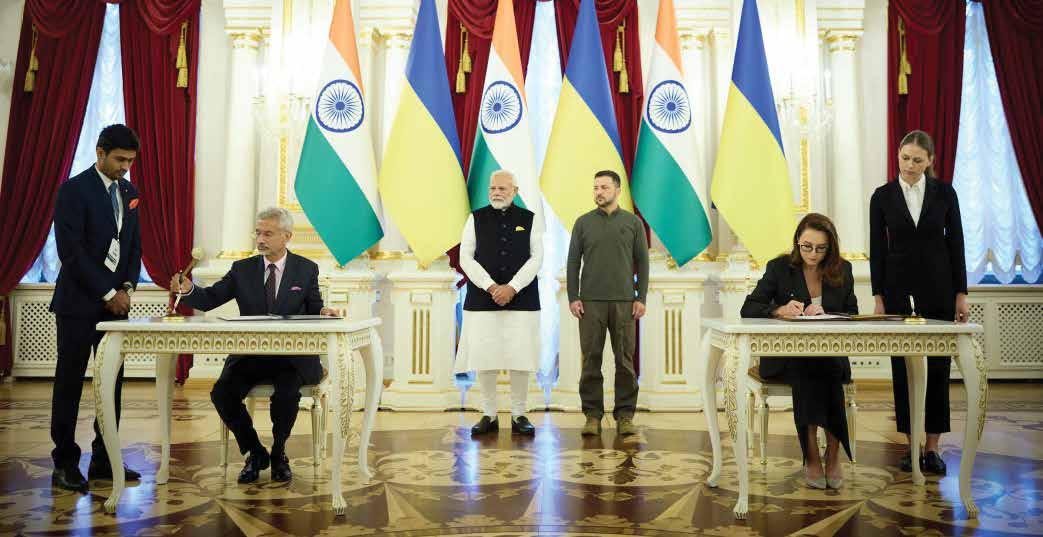
14 minute read
A new era of co-operation
Ashok Sharma considers the India–US strategic partnership under Modi and Biden.
The India–US strategic partnership has significantly evolved under Prime Minister Narendra Modi and President Joe Biden, marking a new era of collaboration. This partnership has deepened across various sectors, including defence, technology, clean energy, health and space exploration, driven by shared democratic values and mutual interests. Amid rising tensions with China, India has become a key partner for the United States in addressing global challenges such as climate change and security in the Indo-Pacific region. Key milestones and areas of co-operation during this transformative period have emphasised the strategic significance of the partnership, which is poised for further growth.
The strategic partnership between India and the United States has undergone a significant transformation under the leadership of Prime Minister Narendra Modi and President Joe Biden. Building on decades of co-operation, the partnership has seen substantial growth in areas like defence, technology, clean energy, health and space exploration, reflecting the mutual desire of both nations to strengthen their bilateral relations. Amid the escalating strategic tensions between the United States and China, India has assumed a significant position in US efforts to combat major global concerns like climate change, artificial intelligence, mending the global supply chain and safeguarding a free, secure and open Indo-Pacific region. This article delves into the key areas of collaboration between India and the United States during the Modi–Biden era, highlighting the important milestones and the strategic importance of this partnership in a changing global order.
Modi has made several important trips to the United States during his time in office. However, his latest visit in late September, and his meeting with Biden, has been much more transformative. India–US relations have come a long way. During the Cold War era, relations between the two countries were not particularly cordial. The end of that confrontation gave both countries new flexibility to mend their relationship. Despite India’s nuclear test in 1998, ties between the two countries continued to improve. Since that time, they have deepened across multiple fields.
The signing of the US–India civilian nuclear accord in 2005 marked a key turning point in the post-Cold War relationship, which removed India from its nearly three-decades-long nuclear pariah status. Ending the system of technological exclusion for India, it paved the way for collaboration in the civilian nuclear energy sector, as well as the transfer of high-tech and sensitive defence technologies to India.1
Significant improvements were made throughout the George W. Bush and Atal Bihari Vajapayee administrations, and India and the United States were positioned as ‘natural allies’. With the rise of China, and in the post-9/11 security environment, both leaders worked to establish a more stable course for the US–India relationship. The current partnership, then, finds its antecedent goodwill in these initial dealings.
The shared commitment to democratic values, principles, a democratic way of life and safeguarding democratic norms and institutions has served as the foundation for both nations’ ties over the years. Modi and Biden affirmed that the US–India partnership must be anchored in upholding democracy, freedom, the rule of law, human rights, pluralism and equal opportunities for all, as both countries strive to become more perfect unions and meet their shared destiny.
Elevating relations
Modi and Biden have ushered in a new phase of the India–US partnership, characterised by heightened engagement and increased dynamism. During their bilateral talks on the sidelines of the Quad Summit in Delaware in September, both leaders reiterated their commitment to further deepening ties between the two countries.²
Modi expressed his appreciation for Biden’s ‘unparalleled contributions’ to enhancing the bilateral relationship, as noted by India’s Ministry of External Affairs. These engagements have brought unprecedented depth to the partnership, and both leaders have emphasised that India and the United States now share a robust global strategic relationship, driven by democratic values, common interests and strong people-to-people connections.
This partnership has evolved into a comprehensive one, encompassing all aspects of human endeavour, from defence and security to economic co-operation, health and education. Both leaders have consistently explored opportunities to strengthen co-operation in key areas of mutual interest and exchanged views on global and regional issues, particularly in the IndoPacific region.
During his first state visit to the United States in June 2023, Modi addressed a joint session of Congress, held talks with Biden and concluded agreements aimed at strengthening the US–India Comprehensive Global and Strategic Partnership. During the bilateral summit, Biden and Modi announced a large number of commitments that covered a wide range of topics, including defence and security, co-operation in space and emerging technologies with a path towards technology transference in jet engines, drones, health, energy and mobility. The two leaders termed the deepening ties between the two countries as the ‘Next Generation Partnership’.³
Global leadership
Under Modi, India has emerged as a key player in global governance, particularly through platforms like the G20 and the Quad. Biden has acknowledged this leadership and praised

Modi’s role in strengthening the Quad, an informal security association between the United States, India, Japan and Australia, which is committed to ensuring a free, open and prosperous Indo-Pacific region. Since the emergence of the Quad in 2004,4 India has played a pivotal role in shaping the group’s objectives and initiatives. Under Modi’s leadership, India has enhanced its engagement with Quad partners, emphasising a free and open Indo-Pacific region. His commitment to multilateral co-operation has significantly strengthened India’s position within the Quad, promoting collaborative efforts in areas such as security, technology and climate change.⁵
India’s efforts to address global challenges, from the Covid-19 pandemic to the consequences of international conflicts, have not gone unnoticed. Biden has lauded Modi’s historic visit to Ukraine and Poland in August, where he delivered a message of peace amidst the on-going conflict between Russia and Ukraine. This visit marked the first time an Indian prime minister had visited Ukraine in decades and symbolised India’s growing role as a global peace broker.
Biden’s endorsement of India’s leadership extends to supporting its bid for a permanent seat on a reformed UN Security Council. India has long sought this position, which would reflect its growing influence on the global stage. The United States backing for this initiative underscores Washington’s recognition of India’s importance in shaping global governance structures.
New frontiers
The India–US partnership is making significant strides in critical and emerging technologies, marking a new era of collaboration. Of central importance is the Initiative on Critical and Emerging Technology (iCET), which aims to enhance co-operation across various sectors, including space, semiconductors, advanced telecommunications, artificial intelligence and quantum technology. These domains are pivotal for shaping the future global economy and security, making collaboration essential for both nations.
Space co-operation has emerged as one of the most promising areas of this partnership. Recent developments include joint scientific research between NASA and the Indian Space Research Organisation (ISRO), culminating in an upcoming mission to the International Space Station in 2025. This collaboration underscores the synergies developing between the United States and India in space exploration, which not only fosters technological advancements but also bolsters national security.
In the semiconductor sector, both countries have committed to establishing manufacturing facilities in India. Aligned with their national security objectives, this initiative addresses the urgent need to diversify semiconductor supply chains — a critical concern highlighted by the Covid-19 pandemic and increasing geopolitical tensions. Strengthening this sector is vital for both nations as they navigate complex global dynamics.

During Modi’s state visit to the United States in 2023, both leaders reaffirmed their commitment to a free, open, inclusive, peaceful and prosperous Indo-Pacific region, emphasising respect for territorial integrity and international law. The strengthening ties between India and the United States have significant implications for geopolitical stability in the Indo-Pacific region, an aspect closely monitored by China.
Chinese assertiveness
China’s assertiveness in emerging technologies and its dominance in renewable energy and space pose challenges. Initiatives like ‘Made in China 2025’ and ‘China Standards 2035’ reflect Beijing’s ambitions to control critical technology industries.⁶ In response, the United States and India are accelerating their defence and technological collaboration, focusing on high-end technologies and addressing emerging concerns related to the digital revolution, including data privacy and cybercrime.
The launch of the iCET in Japan prior to Modi’s United States visit signaled a commitment to advancing collaborative research in various fields, including data science, artificial intelligence, agriculture and environmental science. This broadbased approach to research and development will facilitate the achievement of iCET’s objectives, fostering innovation and mutual trust between the two nations.
The emphasis on artificial intelligence, critical technologies and technology transfer reinforces the growing confidence shared by the United States and India. As the Comprehensive Global and Strategic Partnership evolves, we can expect increased co-operation across the space, defence and technology sectors, paving the way for a robust and forward-looking asssociation. This partnership not only reinforces bilateral relations but also enables both countries to tackle global challenges in a more competitive environment. It is expected to grow even stronger, given the limitless strategic alignment in response to China’s authoritarianism and its aspirations for global dominance.⁷
As India’s importance in critical and emerging technologies continues to grow, its role becomes increasingly vital in shaping the future global economy and security, making co-operation essential for both nations. Although India’s tech engagements may appear transactional and at times inconsistent, they are fundamentally pragmatic, enhancing its appeal as a partner.⁸
Enhancing collaboration
Defence ties between the United States and India have strengthened significantly, with collaboration becoming a vital aspect of their strategic partnership.⁹ Under leaders Modi and Biden, this co-operation has reached new heights. A pivotal milestone in this relationship is India’s acquisition of 31 General Atomics MQ-9B remotely piloted aircraft, which will significantly enhance India’s intelligence, surveillance and reconnaissance capabilities across various domains.
Significant strides have also been made in co-producing defence equipment. The US–India Defense Industrial Cooperation Roadmap aims to establish joint production of critical defence technologies, including jet engines and munitions. This initiative supports India’s goal of ‘Atmanirbhar Bharat’ (self-reliant India) by reducing dependence on foreign military imports.
A noteworthy collaboration was announced between Lockheed Martin and Tata Advanced Systems to create a maintenance, repair and overhaul (MRO) facility for the C-130J Super Hercules aircraft in India, further solidifying India’s role as a regional aerospace hub. Biden expressed support for this agreement, which aims to enhance the readiness of both Indian and global C-130 operators.
The leaders also acknowledged the positive impact of India’s new goods and services tax rate of 5 per cent on the MRO sector, simplifying the tax structure and fostering a robust ecosystem for aviation services in India. US industries are encouraged to invest in MRO capabilities, including support for unmanned aerial vehicles.
The India–US Defense Acceleration Ecosystem (INDUS-X), launched in 2023, has fostered innovative defence collaboration among governments, businesses and academic institutions. Recent summits have seen the signing of memoranda to enhance partnerships, including joint challenges in technologies related to undersea communications and maritime intelligence, surveillance and reconnaissance.
Moreover, the leaders reaffirmed their commitment to deepening military co-operation and inter-operability to ensure a free and open Indo-Pacific region. India recently hosted the largest bilateral tri-service exercise, TIGER TRIUMPH, showcasing advanced capabilities and technologies.
In terms of cyber defence, on-going efforts aim to strengthen the US–India co-operation framework, with upcoming engagements focusing on threat information sharing and cyber-security training. The establishment of liaison officers, including the first Indian officer in US Special Operations Command, marks another step in enhancing military ties.
Overall, the growing defence partnership between India and the United States reflects a shared commitment to advancing security and innovation, setting the stage for a robust, cooperative future in defence and aerospace.
Energy initiatives
As the world grapples with the consequences of climate change, clean energy has become a critical focus of the India–US partnership. Both nations are committed to enhancing clean energy supply chains, particularly through joint manufacturing initiatives in the renewable energy sector.
The leaders endorsed efforts to unlock $1 billion in multilateral financing for clean energy projects, with a focus on renewable energy, green technology and zero-emission vehicles. The US International Development Finance Corporation has already provided substantial loans to Indian companies like Tata Power Solar and First Solar for establishing manufacturing facilities in India. These efforts are part of a broader push to accelerate the transition to clean energy and reduce global carbon emissions.

The collaboration on energy issues reflects India’s pressing need for energy security in a carbon-controlled environment for its developmental goals and aim of lifting millions of people out poverty.10
Another notable initiative is the collaboration on establishing a National Center for Hydrogen Safety in India. Hydrogen is seen as a key component of the future clean energy mix, and this collaboration aims to promote research and development in hydrogen technologies, which have the potential to revolutionise energy systems and reduce reliance on fossil fuels.
Health co-operation
Health co-operation between India and the United States has been further solidified during the Modi–Biden era. One of the standout achievements is the new US–India Drug Policy Framework, which focuses on combating synthetic drug trafficking and enhancing public health collaboration. The opioid crisis in the United States and the growing global threat of synthetic drugs make this partnership particularly timely.
In August, the inaugural US–India Cancer Dialogue took place, marking the beginning of a long-term collaboration aimed at accelerating cancer research and development. This initiative underscores the shared commitment of both nations to improving global health outcomes.
On the economic front, the two leaders emphasised boosting co-operation between US and Indian small- and mediumsized enterprises. This collaboration aims to enhance trade, technology transfers and green economy initiatives, while also addressing regulatory challenges that have historically hindered economic growth.
The India–US strategic partnership under Modi and Biden has emerged as one of the most dynamic and multifaceted bilateral relationships in the world today. It encompasses a wide range of areas, from defence and technology to clean energy and health, reflecting the shared values and interests of both nations.
As the global geopolitical landscape continues to evolve, this partnership will likely play a crucial role in shaping the future of the Indo-Pacific region and beyond. The leadership of Modi and Biden has laid the foundation for even deeper co-operation in the coming years, with both nations committed to working together to address the challenges of the 21st century. This strategic partnership, built on mutual respect and a shared vision for the future, is set to grow stronger, benefiting not only India and the United States but also the broader global community.
Dr Ashok Sharma is a visiting fellow at the Australian Defence Force Academy in Canberra and an academic fellow at the Australia–India Institute at the University of Melbourne. He was the deputy chair of the NZIIA’s Auckland branch from 2012 to 2022.
Notes
1. For details, see Ashok Sharma, Indian Lobbying and its Influence in US Decision Making: Post-Cold War (New Delhi, 2017).
2. The White House, Joint Fact Sheet: ‘The United States and India Continue to Expand Comprehensive and Global Strategic Partnership’, Statements and Releases, 22 Sep 2024 (www.whitehouse.gov/briefing-room/statements-releases/ 2024/09/21/joint-fact-sheet-the-united-states-and-india-continueto-expand-comprehensive-and-global-strategic-partnership/).
3. Ashok Sharma, ‘Narendra Modi’s State Visit to the US: The “Next Generation Partnership”’, Australian Outlook, 7 Aug 2023; The White House, ‘Joint Statement from the United States and India’, 22 Jun 2023 (www.whitehouse.gov/briefing-room/statements-releases/2023/06/22/joint-statement-from-the-united-states-and-india).
4. Ashok Sharma, ‘The Quadrilateral Initiative: An Evaluation’, South Asian Survey, vol 17, no 2 (2012), pp.237–53.
5. PMINDIA, ‘Joint Fact Sheet: The United States and India Continue to Expand Comprehensive and Global Strategic Partnership’, 22 Sep 2024 (www.pmindia.gov.in/en/news_updates/jointfact-sheet-the-united-states-and-india-continue-to-expand-compre hensive-and-global-strategic-partnership/).
6. Yi Wu, ‘China Standards 2035 Strategy: Recent Developments and Implications for Foreign Companies’, China Briefing, 26 Jul 2022 (www.china-briefing.com/news/china-standards-2035-strategy-recent-developments-and-their-implications-foreign-companies/).
7. Ashok Sharma, ‘The Third India–US 2+2 Dialogue: Defence, China, and Indo-Pacific Security’, Australian Outlook, 6 Nov 2023 (www.in ternationalaffairs.org.au/australianoutlook/the-third-india-us-22-dia logue-defence-china-and-indo-pacific-security/).
8. Trisha Ray, ‘India’s Technology Engagement Strategy: Beyond the Quad’, The Diplomat, 22 Sep 2024 (thediplomat. com/2024/09/indias-technology-engagement-strategy-beyondthe-quad/).
9. Ashok Sharma, ‘US–India Defence Industry Collaboration: Trends, Challenges and Prospects’, Maritime Affairs, vol 13, no 1 (2013), pp.129–47.
10. For details, see Ashok Sharma, India’s Pursuit of Energy Security: Domestic Measures, Foreign Policy and Geopolitics (New Delhi, 2019).






